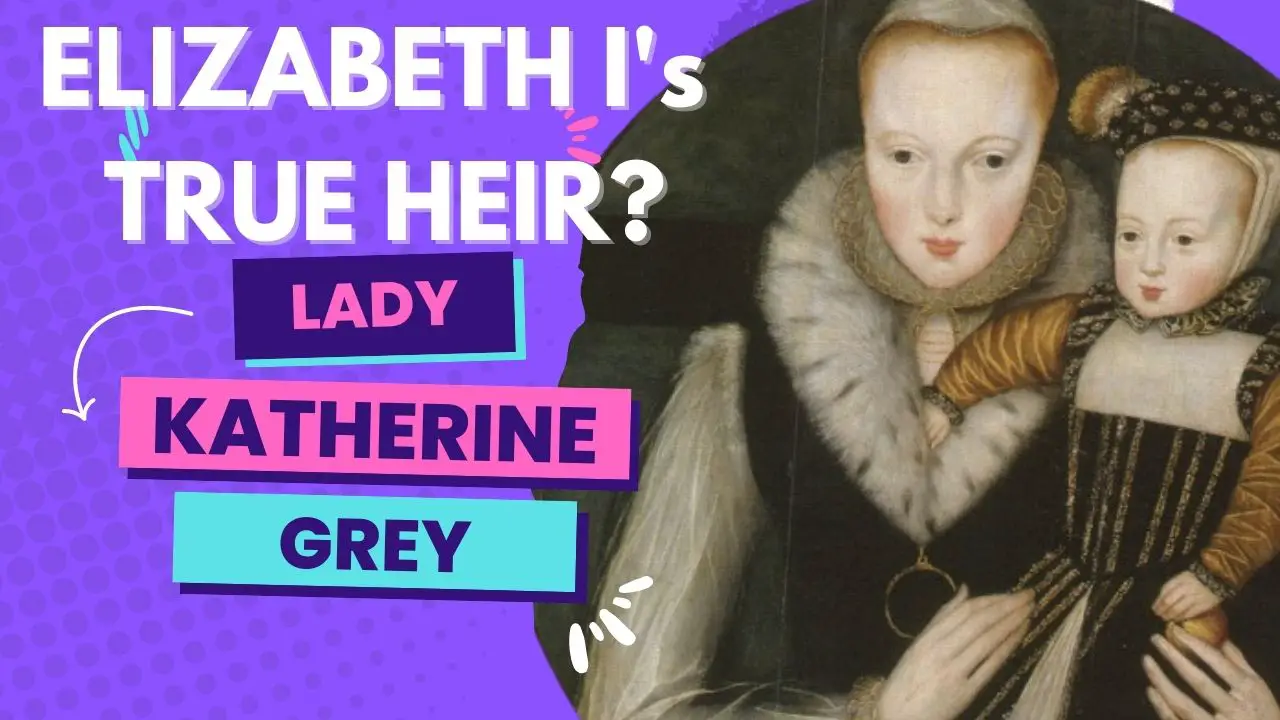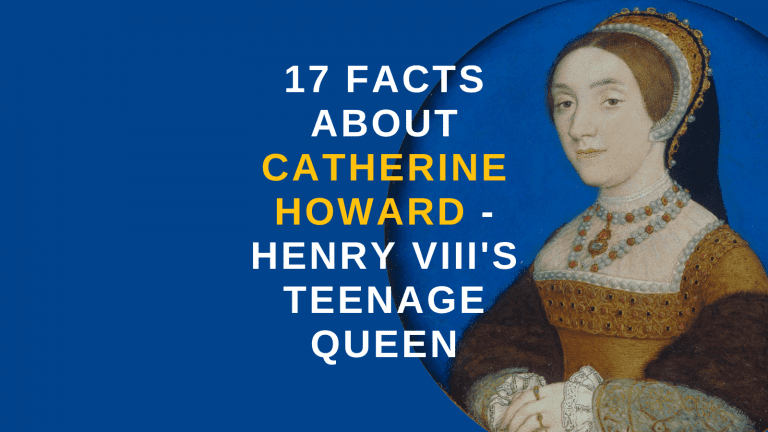Lady Katherine Grey: Elizabeth I’s true heir?
Lady Katherine Grey was born on 25 August 1540 to Lady Frances Brandon and Henry Grey, 1st Duke of Suffolk, at Bradgate Park near Leicester. She was one of three sisters.
At various stages, all three of the Grey sisters could argue that they were the heir to the throne of England. Lady Katherine Grey’s older sister went one step further. She was the ill-fated Lady Jane Grey, who came to be known as ‘the nine days Queen of England’. Katherine’s younger sister Lady Mary Grey, also secretly married and also incurred Elizabeth’s wrath.
How did Lady Katherine Grey have a claim to the throne?
Lady Katherine Grey’s grandmother on her mother’s side was Mary Tudor, the Queen Consort of France, whose mother was Elizabeth of York and whose father was Henry VII. Mary Tudor was Henry VIII’s favourite younger sister.
Her maternal grandfather was Charles Brandon, 1st Duke of Suffolk and best friend of King Henry VIII of England.
The Grey sisters had a claim in the line of succession to the throne of England through their mother, Frances Brandon, daughter of Mary Tudor.
Before them in line for the throne were Henry VIII’s children – Prince Edward, Lady Mary and Lady Elizabeth. The descendants of Henry VII and Mary, Queen of Scots’ elder daughter, Princess Margaret, would have been next in line were it not for Henry VIII excluding the Scottish regal line from English succession in his Will.
This exclusion moved Frances Brandon, the eldest of Henry VIII’s nieces, up the line of succession. Her daughters, the Grey sisters, were next.
When Elizabeth succeeded to the throne, Katherine’s sister Jane Grey had already been executed. When Katherine’s mother, Frances, died around a year later, Lady Katherine Grey became Elizabeth’s heir.
Katherine Grey took part in a triple wedding.
Lady Katherine Grey was betrothed to Henry Herbert sometime before August 1552. Henry was Lord Herbert, heir apparent to William Herbert, 1st Earl of Pembroke. Katherine was just twelve years old. The Grey sisters were to have a double wedding, but on 25 May 1553, Durham House was the venue for a triple wedding. The betrothed couples were Lady Jane Grey and Guildford Dudley, his sister Lady Catherine and Lord Hastings, and finally, Lady Katherine Grey and Lord Herbert.
John Dudley, Duke of Northumberland and leader of the Privy Council, was under no illusions that he would retain any of his power should Mary Tudor be crowned since he went against her staunch support of Catholicism. The king, Edward VI, was not keen on Mary succeeding him either. Mary’s intent to re-establish Papal authority over England was no secret and not a popular possibility among the king and his advisors.
Dudley’s son’s marriage to Lady Jane Grey cemented Dudley’s position in power, but he made two pivotal mistakes. He did not fully judge the support of the people for Mary to be the legitimate ruler. Although Lady Jane Grey was proclaimed Queen after Edward died, Mary also proclaimed herself Queen. Dudley had not adequately secured Mary, and she was able to rally support in Suffolk. Dudley was then late to the party with his march on Suffolk with 2000 soldiers to arrest Mary. Many of the soldiers deserted, and the Privy Council removed their support of “Queen Jane “and proclaimed Mary as Queen. Dudley was arrested and executed on 22 August.
With the failure of the coup, Henry Herbert’s father had his son’s marriage to Lady Katherine Grey annulled in order to distance himself from the Grey family. The marriage was never consummated, and the annulment was likely successful early in 1554. Lady Jane Grey and their father, Henry Grey, Duke of Suffolk, were executed after Wyatt’s Rebellion was suppressed in February 1554.
Edward VI’s devise for the Succession.
Henry VIII’s will and the subsequent Act of Parliament made the line of succession clear.
The fifteen-year-old Edward VI attempted to change that with his own “Devise for the Succession.”
In his own hand, he writes his plans.
Essentially he removed his two half-sisters, Mary and Elizabeth, and replaced them with the Grey sisters and their own issue.
Edward’s aim was to ensure that Mary did not become Queen, as he knew that she would reverse all of his religious reforms. The simplest way was to suggest both of his sisters were illegitimate and, therefore, should not inherit.
Although not legal, and Mary and Elizabeth did both become Queen, it was a further endorsement of Katherine Grey’s claim to the throne.
Katherine Grey’s life under Bloody Mary
Following the attempt to put Lady Jane Grey on the throne, the surname “Grey” was not the most favourable at court.
Jane was executed, as was Henry Grey, the sister’s father.
Frances Brandon, Katherine and Mary Grey’s mother, essentially retired from public life and ended up remarrying. This second marriage was to her servant, Adrian Stokes. This essentially excluded her from ever having a claim on the throne, as her husband was not “high born.”
Despite her reputation, Queen Mary was not unsympathetic. She resisted the demands for the execution of Jane, until the Spanish demanded it in exchange for Philip’s hand in marriage. She understood that the two younger Grey sisters had no part in the attempted coup and therefor gave Katherine Grey and her sister Mary positions as Ladies of the Bedchamber.
Elizabeth’s Heir?
Mary was desperate to leave her throne to her biological child so as to secure England’s future as a Catholic nation. She, however, never did produce a child, and so despite never mentioning Elizabeth by name, Mary reluctantly consented to her succession in accordance with Henry VIII’s will. Mary died on 17 November 1558 and Elizabeth became Queen.
Katherine was regarded as a viable successor to Elizabeth, especially by those courtiers, diplomats and politicians who favoured a Protestant successor. Elizabeth I refused to name a successor to the throne.
Katherine Grey’s fateful second marriage
Lady Katherine Grey married the brother of her good friend, Lady Jane Seymour. He was Edward Seymour, 1st Earl of Hertford, and their marriage by secret ceremony in December 1560 did not have royal assent.
Let’s pause for a second here and get some clarity on who this was.
Katherine’s new husband was Edward Seymour, the son of Edward Seymour, Duke of Somerset, the brother of Queen Jane Seymour and the former Lord Protector of England. Somerset had been executed for treason and was replaced as Edward VI’s chief minister by John Dudley.
Lady Jane Seymour was Edward Seymour Earl Herford’s sister – and was named after her aunt Queen Jane Seymour.
One of the great problems with understanding the Tudor period is that so many of the names were the same. It can cause great confusion.
Lady Jane Seymour was the only witness to the secret wedding between Lady Katherine Grey and Edward Seymour Earl Herford.
Queen Elizabeth despatched Lord Hertford and Thomas Cecil on a tour across Europe “for the improvement of their education” not long after the secret union.
The Earl of Hertford gave Lady Katherine a document to prove their marriage which would allow her to inherit his property should he die. Katherine lost the document and Lady Jane Seymour succumbed to tuberculosis in 1561, leaving Katherine without proof of their marriage.
It proved to be one of the most important lost documents in history.
Katherine Grey’s Imprisonment in the Tower.
Katherine found out that she was pregnant.
Already a threat to Queen Elizabeth’s position as monarch, she had to prove that she and Seymour had been legally wed before she told her.
Were Katherine to produce a son, she knew Elizabeth’s reaction would be even worse. Elizabeth had a huge problem with women close to her and the throne marrying and having children. Becoming frantic in her eighth month, Katherine approached Bess of Hardwick, pleading for her to intercede with the Queen on her behalf. Bess scolded her and refused to help.
Katherine then approached Robert Dudley, her brother-in-law and the Queen’s favourite, for his help. Legend has it Katherine Grey appeared in Dudley’s bed chamber in the dead of night, in floods of tears and obviously heavily pregnant. As Dudley and Elizabeth’s chambers were next to each other (a story for another time) he didn’t want to be found in this strange situation.
Dudley immediately told the Queen, who imprisoned Katherine and Edward Seymour in the Tower of London.
Katherine’s son, Edward Seymour, Lord Beauchamp, (see how confusing the names can be) was born in the tower in 1561. In May 1562, the Archbishop of Canterbury declared Katherine and Edward to have not been lawfully wed, and she was charged with fornication.
Katherine Grey managed to fall pregnant when imprisoned in the tower.
Lady Katherine Grey and Edward had been given the opportunity to be together during their imprisonment by Lieutenant of the Tower, Edward Warner.
Warner did not foresee Katherine falling pregnant for a second time due to his kindness in allowing what were apparently conjugal visits.
Did Lady Katherine Grey’s children ever claim the throne?
Edward Seymour, Lord Beauchamp of Hache was by 1603 the senior qualified heir according to the stipulations of the will of King Henry VIII, that the descendants of the elder line of Margaret Tudor (the Tudor dynasty) should be passed over in favour of the younger line, descended from Mary Tudor.
Henry VIII’s will was, however disregarded, leaving King James VI of Scotland to take over the English throne on Elizabeth’s death.
Of course, there was another barrier to Edward Seymour claiming the throne. Since Queen Elizabeth I never sanctioned Katherine Grey and Edward Seymour’s marriage, both their sons, Edward and Thomas, were declared illegitimate.
House arrest and death
When Katherine gave birth to her second child, Thomas, in 1563, the Queen ordered that Katherine and her husband and older son be permanently separated.
Edward, their firstborn, was put under house arrest in Hanworth. Katherine and baby Thomas were sent to live in her uncle John Grey’s home Pirgo in Essex where they would be treated as prisoners.
She stayed at Pirgo until November 1564 and then spent the next two years in the custody of Sir William Petre. She spent a further seventeen months confined to Gosfield Hall and then Cockfield Hall at Yoxford in Suffolk.
Katherine was suffering from tuberculosis by this time and had no desire to be well again. In bed, starving and depressed, her last thoughts were of her husband. A letter to the Queen begged her forgiveness and that she pardon Edward Seymour.
Lady Katherine Grey died on 26/27 January 1568 at Cockfield Hall, fourteen days after declaring her love for Edward in a letter. She had spent almost seven years of her twenty-seven years imprisoned.
Burial and Exhumation to Salisbury Cathedral
Elizabeth faked some measure of sorrow and allowed Katherine a suitable funeral. She was buried in the Cockfield Chapel in Yoxford church in Suffolk, but her grandson had her remains exhumed to be interred in a grand tomb in Salisbury Cathedral at her beloved Edward Seymour’s side.






